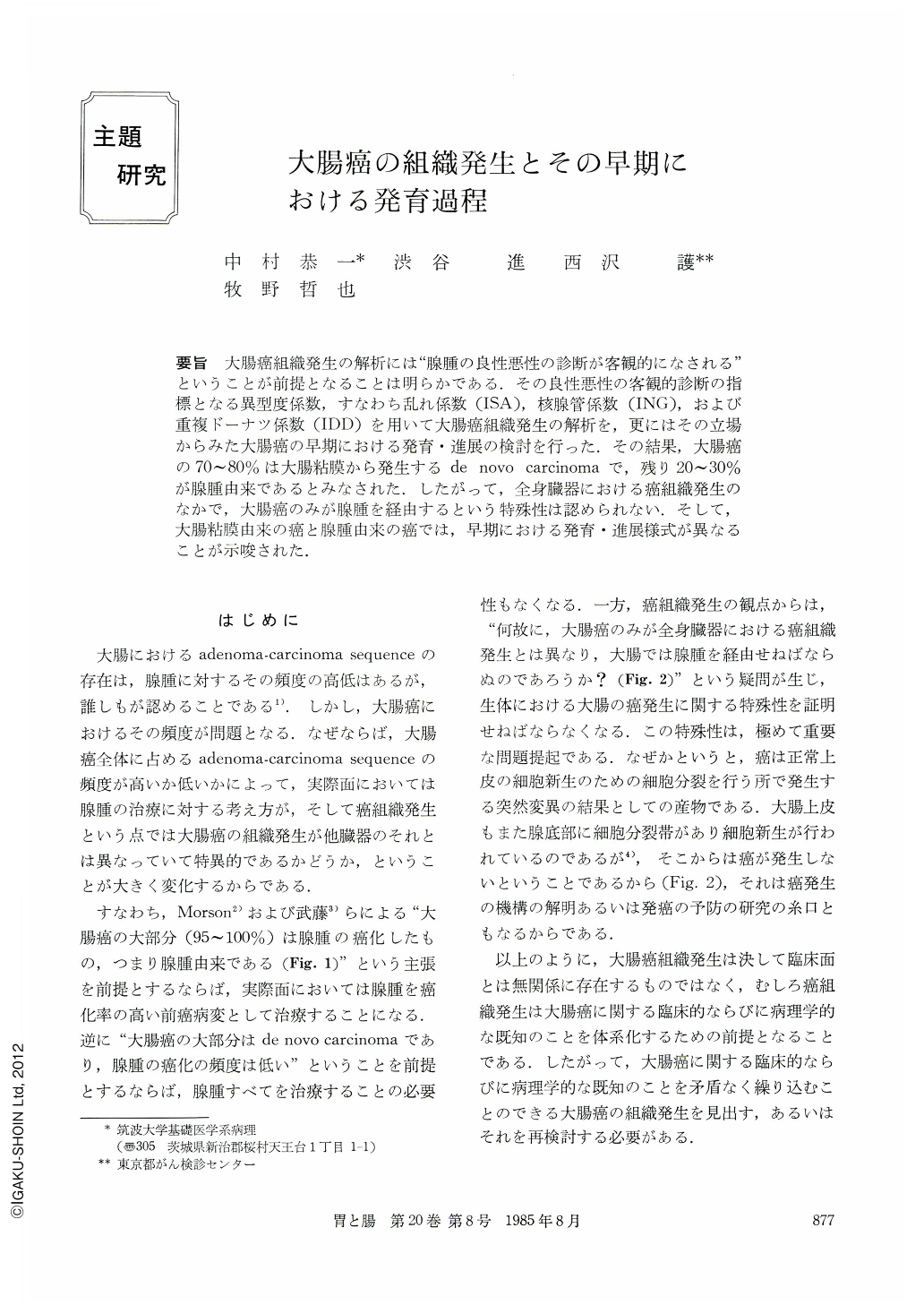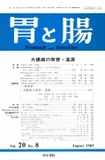Japanese
English
- 有料閲覧
- Abstract 文献概要
- 1ページ目 Look Inside
- サイト内被引用 Cited by
要旨 大腸癌組織発生の解析には“腺腫の良性悪性の診断が客観的になされる”ということが前提となることは明らかである.その良性悪性の客観的診断の指標となる異型度係数,すなわち乱れ係数(ISA),核腺管係数(ING),および重複ドーナツ係数(IDD)を用いて大腸癌組織発生の解析を,更にはその立場からみた大腸癌の早期における発育・進展の検討を行った.その結果,大腸癌の70~80%は大腸粘膜から発生するde novo carcinomaで,残り20~30%が腺腫由来であるとみなされた.したがって,全身臓器における癌組織発生のなかで,大腸癌のみが腺腫を経由するという特殊性は認められない.そして,大腸粘膜由来の癌と腺腫由来の癌では,早期における発育・進展様式が異なることが示唆された.
Regarding histogenesis of carcinoma of the colon and rectum, Morson, B. C. (1972) and Muto, T. (1982) have strongly mentioned that the great majority of carcinoma of the colon and rectum arises from adenoma, and de novo cancer is very rare (Fig. 1). However, perceiving the histogenesis, it gives rise to two big problems about human carcinogenesis as shown in Fig. 2.
Meanwhile, in case of studying adenoma-carcinoma sequence of the colon and rectum, it is decidedly required that histological diagnosis is objectively made whether it is malignant or not. Because, it is premise for analysing the histogenesis (Figs. 3 and 4).
The purpose of this paper is to study the histogenesis of carcinoma of the colon and rectum by using objective indices of grade of atypicality (ISA, ING, IDD) previously reported by us (1982-1984)7-10) (Table 1, Figs. 2 and 5).
Hereupon, benign adenoma is defined as values of the indices ranging from (Mean-1SD) to (Mean+2SD) (Fig. 6). When two out of three indices in a certain area of dysplastic lesion show values over (Mean+2SD) of benign adenoma, the lesion is interpreted as malignant. Dysplastic lesion being a few glands, only the value of ING is used for interpretation.
Ninety-one carcinomas measuring less than 2cm in largest diameter and totally or partially showing malignant values of ISA and ING are obtained by measurement of dysplastic lesions and carcinoma of the colon and rectum. Forty-four out of the 91 carcinomas measured less than 1cm in largest diameter, and remnant 47 ones did 1.1 to 2.0cm in largest diameter.
In the 44 carcinomas measuring less than 1cm in largest diameter (Table 3), 34 carcinomas (77%) were not concomitant to dysplastic glands showing values of ISA and ING of the benign lesion anywhere. The majority of glands histologically interpreted as slight dysplasia showed values of normal or hyperplastic glands (Figs. 7-9). Meanwhile, the major part of glands histologically interpreted as severe dysplasia showed values of carcinoma (Figs. 10-12). Remnant 10 out of the 44 carcinomas were associated with adenomatous glands showing benign values of ISA and ING (Table 3).
In the 47 carcinomas measuring 1.1 to 2.0cm in largest diameter (Table 4), 26 carcinomas (55%) were not concomitant to benign dysplastic glands, and remnant 21 ones (45%) were associated with benign adenomatous glands.
In 31 carcinomas associated with adenoma (Table 5), frequency of carcinomas measuring 1.1 to 2.0cm in largest diameter is approximately twice than that measuring less of 1.0cm in largest diameter. It may be considered that probability of malignant change of adenoma per unit volume is constant.
It seems reasonable to conclude from these data that about 70% carcinomas of the colon and rectum arise from tha flat mucosa (de novo cancer) and about 30% ones arise from adenomas (Fig. 13). From the view-point of this conclusion, the two big problems mentioned-above are logically solved.
Classifying the 91 carcinomas according to the histogenesis derived in this study, frequency of submucosal invasion is very different to each other (Table 7). In the 34 de novo carcinomas measuring less than 1.0cm in largest diameter (Table 8), 26 carcinomas (76%) were limited to the mucosa and remnant 8 ones invade the submucosa, and in the 26 de novo carcinomas measuring 1.1 to 2.0cm in largest diameter, 11 carcinomas (42%) were limited to the mucosa and the remnant 15 ones (58%) invade the submucosa.
These results lead us to a conclusion that de novo carcinoma has a tendency to easily invade the submucosa as compared with carcinoma associated with adenoma.

Copyright © 1985, Igaku-Shoin Ltd. All rights reserved.


